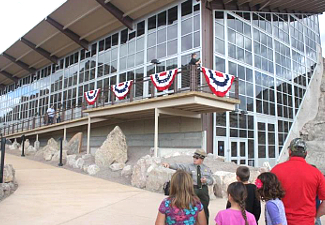
Photo above: View of the Yampa River above Castle Park in Dinosaur National Monument. Right: Dinosaur remnants still embedded in the Quarry at Dinosaur National Monument. Source: National Park Service.

Dinosaur National Monument
It's a unique environment with different adventures around each corner of the park. Yes, there's those dinosaurs, in put together detail, in portraits, statues, and the most remarkable of them all, an exhibit hall of a dinosaur quarry where the remnants of the creatures are still embedded in the rock. And you can walk right up to them. Even touch some. But don't think there's not a lot more here than Jurassic details, although you might dream of some of those combined with a movie montage the night after your visit. This park is larger than some think and contains petroglyphs from the Fremont culture in the southeast Uinta Mountain, camping opportunities in a variety of settings, and river experiences on rivers Green and Yampa that dip beneath rock monoliths.
Sponsor this page. Your banner or text ad can fill the space above.
Click here to Sponsor the page and how to reserve your ad.

Dinosaur National Monument Then
Dinosaurs. They're from the Jurassic period, one hundred fifty million years ago, carried by the rivers and embedded in the rock. The fossil beds were unearthed by Earl Douglass in 1909. He was working for the Carnegie Museum of Natural History and sent his findings back to Pittsburgh to be studied and displayed.
Fremont Culture. Pre-Columbian Native American culture in Utah surrounding the area of the Fremont River. The Fremont lived in the monument area from 200 to 1300 A.D. and their pictographs and petroglyphs are witness to their life amid the valleys and mountains. What is the difference between the two forms of art? A pictograph is a rock wall painting. A petroglyph is a chipped carving in the rock.
Photo above: Petroglyphs from Fremont culture at Dinosaur National Monument. Photo courtesy Wikipedia Commons. Below: Winter scene on the Green River in Dinosaur National Monument. Source: National Park Service.

Dinosaur National Monument Now
There are two unique sides to the park, almost split by the state divisions. If you want to visit the namesake dinosaurs, head to Utah and the Quarry Visitor Center. From there, the rangers will take you to the quarry building itself. For more recreational pursuits, you'll likely spend more time in Colorado along the Yampa and Green Rivers. Start on Route 40 at the Canyon Visitor Center, then head north on Harpers Corner Road. There are other entry points to the park, which the more experienced Dinosaur National Monument visitors will likely inhabit. But if this is your first time here, head to one of the first two for orientation, ranger talks, and exhibits.
It's been a National Monumet since October 4, 1915. Only eighty acres at the beginning. A major expansion of its land occurred in 1938, bringing it close to the now two hundred thousands acres within its borders. The original Quarry building was built in the 1950's and is now restored. Fremont culture remains a large part of the history here as well. Yes, newer than the dinosaurs, but certainly not new. The Castle Park Archaeological District was inhabited by the Fremont culture and the Ute and Shoshone. Mantle's Cave, a cliff alcove 330' wide and 130' deep, was found by local ranchers in 1921.
The pictographs and petroglyphs of the Fremont can be found around the park; Swelter Shelter, Cub Creek, Deluge Shelter, McKee Springs, and Pool Creek are some of the most visited areas.
T-Shirts and Souvenirs

Dinosaur National Monument T-Shirts and Souvenirs from the official merchandise of America's Best History. Great for your next western vacation or planning session.

Dinosaur National Monument
Things You Should Not Miss
1. Take a trip to the quarry and see the bones of dinosaurs right in front of you still embedded in the rock. Stop at the Quarry Visitor Center and take a shuttle ride to the building where dinosaurs, Jurrasic, and national parks combine to show you a real Jurassic Park.
2. From late May to September, you can follow a ranger into the park on guided tours of the fossil kind or campground evenings on geology. Check at the Quarry Visitor Center for when, where, and how difficult the walks or talks may be.
3. Hike the park. There are defined trails for a variety of abilities and you are allowed to wander off the trails here. The defined trails range from 1/4 mile interpretive trails like Plug Hat to remote trails 16 miles in length back and forth like the Island Park Trail. That trail is hot, with almost no shade, and can be difficult.
4. Dinosaur National Monument, particularly on the Colorado side, is a place for outdoor adventure. Both the Green and Yampa River provide water for your rafting and tubing pleasure, but they are not easy rivers to traverse. Take care on the water and experience it with caution, whether you are doing a private tour (permit required) or guided tour.
Photo above: Split Mountain Canyon at Dinosaur National Monument. Courtesy National Park Service.





